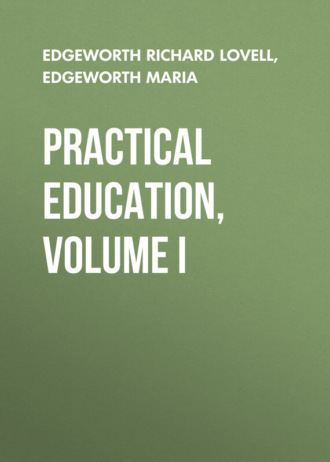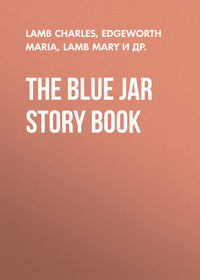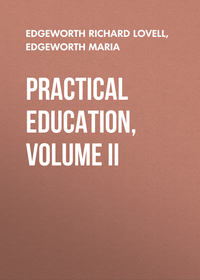 полная версия
полная версияPractical Education, Volume I
Prints for children should be chosen with great care; they should represent objects which are familiar; the resemblances should be accurate, and the manners should be attended to, or at least, the general moral that is to be drawn from them. The attitude of Sephora, the boxing lady in Gil Blas, must appear unnatural to children who have not lived with termagant heroines. Perhaps, the first ideas of grace, beauty, and propriety, are considerably influenced by the first pictures and prints which please children. Sir Joshua Reynolds tells us, that he took a child with him through a room full of pictures, and that the child stopped, with signs of aversion, whenever it came to any picture of a figure in a constrained attitude.
Children soon judge tolerably well of proportion in drawing, where they have been used to see the objects which are represented: but we often give them prints of objects, and of animals especially, which they have never seen, and in which no sort of proportion is observed. The common prints of animals must give children false ideas. The mouse and the elephant are nearly of the same size, and the crocodile and whale fill the same space in the page. Painters, who put figures of men amongst their buildings, give the idea of the proportionate height immediately to the eye: this is, perhaps, the best scale we can adopt; in every print for children this should be attended to. Some idea of the relative sizes of the animals they see represented would then be given, and the imagination would not be filled with chimeras.
After having been accustomed to examine prints, and to trace their resemblance to real objects, children will probably wish to try their own powers of imitation. At this moment no toy, which we could invent for them, would give them half so much pleasure as a pencil. If we put a pencil into their hands even before they are able to do any thing with it but make random marks all over a sheet of paper, it will long continue a real amusement and occupation. No matter how rude their first attempts at imitation may be; if the attention of children be occupied, our point is gained. Girls have generally one advantage at this age over boys, in the exclusive possession of the scissors: how many camels, and elephants with amazing trunks, are cut out by the industrious scissors of a busy, and therefore happy little girl, during a winter evening, which passes so heavily, and appears so immeasurably long, to the idle.
Modelling in clay or wax might probably be a useful amusement about this age, if the materials were so prepared, that the children could avoid being every moment troublesome to others whilst they are at work. The making of baskets, and the weaving of sash-line, might perhaps be employment for children; with proper preparations, they might at least be occupied with these things; much, perhaps, might not be produced by their labours, but it is a great deal to give early habits of industry. Let us do what we will, every person who has ever had any experience upon the subject, must know that it is scarcely possible to provide sufficient and suitable occupations for young children: this is one of the first difficulties in education. Those who have never tried the experiment, are astonished to find it such a difficult and laborious business as it really is, to find employments for children from three to six years old. It is perhaps better, that our pupils should be entirely idle, than that they should be half employed. "My dear, have you nothing to do?" should be spoken in sorrow rather than in anger. When they see other people employed and happy, children feel mortified and miserable to have nothing to do. Count Rumford's was an excellent scheme for exciting sympathetic industry amongst the children of the poor at Munich; in the large hall, where the elder children were busy in spinning, there was a range of seats for the younger children, who were not yet permitted to work; these being compelled to sit idle, and to see the busy multitude, grew extremely uneasy in their own situation, and became very anxious to be employed. We need not use any compulsion or any artifice; parents in every family, we suppose, who think of educating their own children, are employed some hours in the day in reading, writing, business, or conversation; during these hours, children will naturally feel the want of occupation, and will, from sympathy, from ambition and from impatience of insupportable ennui, desire with anxious faces, "to have something to do." Instead of loading them with playthings, by way of relieving their misery, we should honestly tell them, if that be the truth, "I am sorry I cannot find any thing for you to do at present. I hope you will soon be able to employ yourself. What a happy thing it will be for you to be able, by and by, to read, and write and draw; then you will never be forced to sit idle."
The pains of idleness stimulate children to industry, if they are from time to time properly contrasted with the pleasures of occupation. We should associate cheerfulness, and praise, and looks of approbation, with industry; and, whenever young people invent employments for themselves, they should be assisted as much as possible, and encouraged. At that age when they are apt to grow tired in half an hour of their playthings, we had better give them playthings only for a very short time, at intervals in the day; and, instead of waiting till they are tired, we should take the things away before they are weary of them. Nor should we discourage the inquisitive genius from examining into the structure of their toys, whatever they may be. The same ingenious and active dispositions, which prompt these inquiries, will secure children from all those numerous temptations to do mischief, to which the idle are exposed. Ingenious children are pleased with contrivances which answer the purposes for which they are intended: and they feel sincere regret whenever these are injured or destroyed: this we mention as a further comfort and security for parents, who, in the company of young mechanics, are apt to tremble for their furniture. Children who observe, and who begin to amuse themselves with thought, are not so actively hostile in their attacks upon inanimate objects. We were once present at the dissection of a wooden cuckoo, which was attended with extreme pleasure by a large family of children; and it was not one of the children who broke the precious toy, but it was the father who took it to pieces. Nor was it the destruction of the plaything which entertained the company, but the sight of the manner in which it was constructed. Many guesses were made by all the spectators about the internal structure of the cuckoo, and the astonishment of the company was universal, when the bellows were cut open, and the simple contrivance was revealed to view; probably, more was learnt from this cuckoo, than was ever learnt from any cuckoo before. So far from being indifferent to the destruction of this plaything, H – the little girl of four years old, to whom it belonged, remembered, several months afterwards, to remind her father of his promise to repair the mischief he had done.
"Several toys, which are made at present, are calculated to give pleasure merely by exciting surprise, and of course give children's minds such a tone, that they are afterwards too fond of similar useless baubles."3 This species of delight is soon over, and is succeeded by a desire to triumph in the ignorance, the credulity, or the cowardice, of their companions. Hence that propensity to play tricks, which is often injudiciously encouraged by the smiles of parents, who are apt to mistake it for a proof of wit and vivacity. They forget, that "gentle dulness ever loved a joke;" and that even wit and vivacity, if they become troublesome and mischievous, will be feared, and shunned. Many juggling tricks and puzzles are highly ingenious; and, as far as they can exercise the invention or the patience of young people, they are useful. Care, however, should be taken, to separate the ideas of deceit and of ingenuity, and to prevent children from glorying in the mere possession of a secret.
Toys which afford trials of dexterity and activity, such as tops, kites, hoops, balls, battledores and shuttlecocks, ninepins, and cup-and-ball, are excellent; and we see that they are consequently great and lasting favourites with children; their senses, their understanding, and their passions, are all agreeably interested and exercised by these amusements. They emulate each other; but, as some will probably excel at one game, and some at another, this emulation will not degenerate into envy. There is more danger that this hateful passion should be created in the minds of young competitors at those games, where it is supposed that some knack or mystery is to be learned before they can be played with success. Whenever children play at such games, we should point out to them how and why it is that they succeed or fail: we may show them, that, in reality, there is no knack or mystery in any thing, but that from certain causes certain effects will follow; that, after trying a number of experiments, the circumstances essential to success may be discovered; and that all the ease and dexterity, which we often attribute to the power of natural genius, is simply the consequence of practice and industry. This sober lesson may be taught to children without putting it into grave words or formal precepts. A gentleman once astonished a family of children by his dexterity in playing at bilboquet: he caught the ball nine or ten times successively with great rapidity upon the spike: this success appeared miraculous; and the father, who observed that it had made a great impression upon the little spectators, took that opportunity to show the use of spinning the ball, to make the hole at the bottom ascend in a proper direction. The nature of centrifugal motion, and its effect, in preserving the parallelism of motion, if we may be allowed the expression, was explained, not at once, but at different intervals, to the young audience. Only as much was explained at a time as the children could understand, without fatiguing their attention, and the abstruse subject was made familiar by the mode of illustration that was adopted.
It is surprising how much children may learn from their playthings, when they are judiciously chosen, and when the habit of reflection and observation is associated with the ideas of amusement and happiness. A little boy of nine years old, who had had a hoop to play with, asked "why a hoop, or a plate, if rolled upon its edge, keeps up as long as it rolls, but falls as soon as it stops, and will not stand if you try to make it stand still upon its edge?" Was not the boy's understanding as well employed whilst he was thinking of this phenomenon, which he observed whilst he was beating his hoop, as it could possibly have been by the most learned preceptor?
When a pedantic schoolmaster sees a boy eagerly watching a paper kite, he observes, "What a pity it is that children cannot be made to mind their grammar as well as their kites!" And he adds, perhaps, some peevish ejaculation on the natural idleness of boys, and that pernicious love of play against which he is doomed to wage perpetual war. A man of sense will see the same thing with a different eye; in this pernicious love of play he will discern the symptoms of a love of science, and, instead of deploring the natural idleness of children, he will admire the activity which they display in the pursuit of knowledge. He will feel that it is his business to direct this activity, to furnish his pupil with materials for fresh combinations, to put him or to let him put himself, in situations where he can make useful observations, and acquire that experience which cannot be bought, and which no masters can communicate.
It will not be beneath the dignity of a philosophic tutor to consider the different effects, which the most common plays of children have upon the habits of the understanding and temper. Whoever has watched children putting together a dissected map, must have been amused with the trial between Wit and Judgment. The child, who quickly perceives resemblances, catches instantly at the first bit of the wooden map, that has a single hook or hollow that seems likely to answer his purpose; he makes, perhaps, twenty different trials before he hits upon the right; whilst the wary youth, who has been accustomed to observe differences, cautiously examines with his eye the whole outline before his hand begins to move; and, having exactly compared the two indentures, he joins them with sober confidence, more proud of never disgracing his judgment by a fruitless attempt, than ambitious of rapid success. He is slow, but sure, and wins the day.
There are some plays which require presence of mind, and which demand immediate attention to what is actually going forward, in which children, capable of the greatest degree of abstract attention, are most apt to be defective. They have many ideas, but none of them ready, and their knowledge is useless, because it is recollected a moment too late. Could we, in suitably dignified language, describe the game of "birds, beasts, and fishes," we should venture to prescribe it as no very painful remedy for these absent and abstracted personages. When the handkerchief or the ball is thrown, and when his bird's name is called for, the absent little philosopher is obliged to collect his scattered thoughts instantaneously, or else he exposes himself to the ridicule of naming, perhaps, a fish or a beast, or any bird but the right. To those children, who, on the contrary, are not sufficiently apt to abstract their attention, and who are what Bacon calls "birdwitted," we should recommend a solitary-board. At the solitary-board they must withdraw their thoughts from all external objects, hear nothing that is said, and fix their attention solely upon the figure and the pegs before them, else they will never succeed; and, if they make one errour in their calculations, they lose all their labour. Those who are precipitate, and not sufficiently attentive to the consequences of their own actions, may receive many salutary lessons at the draught or chess-board – happy, if they can learn prudence and foresight, by frequently losing the battle.
We are not quite so absurd as to imagine, that any great or permanent effects can be produced by such slight causes as a game at draughts, or at a solitary-board, but the combination of a number of apparent trifles, is not to be neglected in education.
We have never yet mentioned what will probably first occur to those who would invent employments for children. We have never yet mentioned a garden; we have never mentioned those great delights to children, a spade, a hoe, a rake, and a wheelbarrow. We hold all these in proper respect; but we did not sooner mention them, because, if introduced too early, they are useless. We must not expect, that a boy six or seven years old, can find, for any length of time, sufficient daily occupation in a garden: he has not strength for hard labour; he can dig soft earth; he can weed groundsel, and other weeds, which take no deep root in the earth; but after he has weeded his little garden, and sowed his seeds, there must be a suspension of his labours. Frequently children, for want of something to do, when they have sowed flower-seeds in their crooked beds, dig up the hopes of the year to make a new walk, or to sink a well in their garden. We mention these things, that parents may not be disappointed, or expect more from the occupation of a garden, than it can, at a very early age, afford. A garden is an excellent resource for children, but they should have a variety of other occupations: rainy days will come, and frost and snow, and then children must be occupied within doors. We immediately think of a little set of carpenter's tools, to supply them with active amusement. Boys will probably be more inclined to attempt making models, than drawings of the furniture which appears to be the most easy to imitate; they will imagine that, if they had but tools, they could make boxes, and desks, and beds, and chests of drawers, and tables and chairs innumerable. But, alas! these fond imaginations are too soon dissipated. Suppose a boy of seven years old to be provided with a small set of carpenter's tools, his father thinks perhaps that he has made him completely happy; but a week afterwards the father finds dreadful marks of the file and saw upon his mahogany tables; the use of these tools is immediately interdicted until a bench shall be procured. Week after week passes away, till at length the frequently reiterated speech of "Papa, you bid me put you in mind about my bench." "Papa" has its effect, and the bench appears. Now the young carpenter thinks he is quite set up in the world, and projects carts and boxes, and reading-desks and writing-desks for himself and for his sisters, if he have any; but when he comes to the execution of his plans, what new difficulties, what new wants arise! the wood is too thick or too thin; it splits, or it cannot be cut with a knife; wire, nails, glue, and above all, the means of heating the glue, are wanting. At last some frail machine, stuck together with pegs or pins, is produced, and the workman is usually either too much ridiculed, or too much admired. The step from pegging to mortising is a very difficult step, and the want of a mortising-chisel is insuperable: one tool is called upon to do the duty of another, and the pricker comes to an untimely end in doing the hard duty of the punch; the saw wants setting; the plane will plane no longer; and the mallet must be used instead of the hammer, because the hammer makes so much noise, that the ladies of the family have voted for its being locked up. To all these various evils the child submits in despair; and finding, after many fruitless exertions, that he cannot make any of the fine things he had projected, he throws aside his tools, and is deterred by these disappointments from future industry and ingenuity. Such are the consequences of putting excellent tools into the hands of children before they can possibly use them: but the tools which are useless at seven years old, will be a most valuable present at eleven or twelve, and for this age it will be prudent to reserve them. A rational toy-shop should be provided with all manner of carpenter's tools, with wood properly prepared for the young workman, and with screws, nails, glue, emery-paper, and a variety of articles which it would be tedious to enumerate; but which, if parents could readily meet within a convenient assemblage, they would willingly purchase for their children. The trouble of hunting through a number of different shops, prevents them at present from purchasing such things; besides, they may not perhaps be sufficiently good carpenters to know distinctly every thing that is necessary for a young workman.
Card, pasteboard, substantial but not sharp-pointed scissors, wire, gum and wax, may, in some degree, supply the want of carpenter's tools at that early age when we have observed that the saw and plane are useless. Models of common furniture should be made as toys, which should take to pieces, so that all their parts, and the manner in which they are put together, might be seen distinctly; the names of the different parts should be written4 or stamped upon them: by these means the names will be associated with realities; children will retain them in their memory, and they will neither learn by rote technical terms, nor will they be retarded in their progress in mechanical invention by the want of language. Before young people can use tools, these models will amuse and exercise their attention. From models of furniture we may go on to models of architecture; pillars of different orders, the roofs of houses, the manner of slating and tiling, &c. Then we may proceed to models of simple machines, choosing at first such as can be immediately useful to children in their own amusements, such as wheelbarrows, carts, cranes, scales, steelyards, jacks, and pumps, which children ever view with eager eyes.
From simple, it will be easy to proceed gradually to models of more complicated, machinery: it would be tiresome to give a list of these; models of instruments used by manufacturers and artists should be seen; many of these are extremely ingenious; spinning-wheels, looms, paper-mills, wind-mills, water-mills, might with great advantage be shown in miniature to children.
The distracting noise and bustle, the multitude of objects which all claim the attention at once, prevent young people from understanding much of what they see, when they are first taken to look at large manufactories. If they had previously acquired some general idea of the whole, and some particular knowledge of the different parts, they would not stare when they get into these places; they would not "stare round, see nothing, and come home content," bewildered by the sight of cogs and wheels; and the explanations of the workmen would not be all jargon to them; they would understand some of the technical terms, which so much alarm the intellects of those who hear them for the first time.
We may exercise the ingenuity and judgment of children by these models of machines, by showing them first the thing to be done, and exciting them to invent the best means of doing it; afterwards give the models as the reward for their ingenuity, and let them compare their own inventions with the contrivances actually in use amongst artificers; by these means, young people may be led to compare a variety of different contrivances; they will discern what parts of a machine are superfluous, and what inadequate, and they will class particular observations gradually under general principles. It may be thought, that this will tend to give children only mechanical invention, or we should call it, perhaps, the invention of machines; and those who do not require this particular talent, will despise it as unnecessary in what are called the liberal professions. Without attempting to compare the value of different intellectual talents, we may observe, that they are all in some measure dependent upon each other. Upon this subject we shall enlarge more fully when we come to consider the method of cultivating the memory and invention.
Chemical toys will be more difficult to manage than mechanical, because the materials, requisite to try many chemical experiments, are such as cannot safely be put into the hands of children. But a list of experiments, and of the things necessary to try them, might easily be drawn out by a chemist who would condescend to such a task; and if these materials, with proper directions, were to be found at a rational toy-shop, parents would not be afraid of burning or poisoning their children in the first chemical lessons. In some families, girls are taught the confectionary art; might not this be advantageously connected with some knowledge of chemistry, and might not they be better taught than by Mrs. Raffeld or Mrs. Glass?5 Every culinary operation may be performed as an art, probably, as well by a cook as by a chemist; but, if the chemist did not assist the cook now and then with a little science, epicures would have great reason for lamentation. We do not, by any means, advise that girls should be instructed in confectionary arts, at the hazard of their keeping company with servants. If they learn any thing of this sort, there will be many precautions necessary to separate them from servants: we do not advise that these hazards should be run; but if girls learn confectionary, let them learn the principles of chemistry, which may assist in this art.6
Children are very fond of attempting experiments in dying, and are very curious about vegetable dyes; but they can seldom proceed for want of the means of boiling, evaporating, distilling, and subliming. Small stills, and small tea-kettles and lamps, would be extremely useful to them: these might be used in the room with the children's parents, which would prevent all danger: they should continue to be the property of the parents, and should be produced only when they are wanted. No great apparatus is necessary for showing children the first simple operations in chemistry: such as evaporation, crystalization, calcination, detonation, effervescence, and saturation. Water and fire, salt and sugar, lime and vinegar, are not very difficult to be procured; and a wine-glass is to be found in every house. The difference between an acid and alkali should be early taught to children; many grown people begin to learn chemistry, without distinctly knowing what is meant by those terms.








